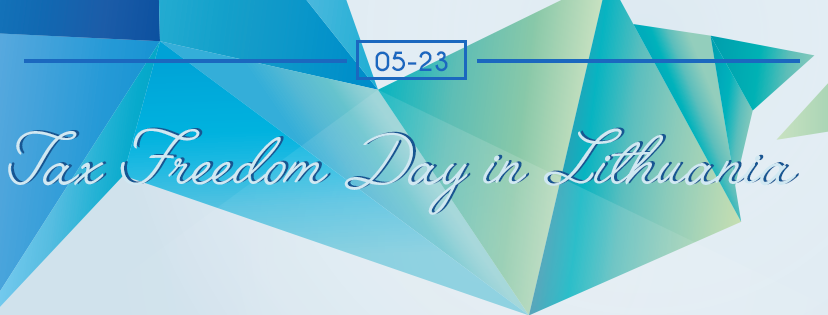May 23, 2017 – the symbolic Tax Freedom Day, marking the day when an average taxpayer has paid all the dues to the government and begins to work for himself, falls in Lithuania. This year the Tax Freedom Day comes five days later; regrettably, government spending surpasses economic growth and Lithuanian taxpayers should work more and more just to pay taxes. To compare, Estonia celebrated on May 7, the United States on April 23, and Australia on April 13.
“On average, each Lithuanian citizen will pay EUR 4,243 in taxes in 2017, totalling to over EUR 12 billion. This symbolic day is meant to draw attention to the increasing amount of money that Lithuanian citizens pay in taxes as well as to the ever-growing government expenditure. Unfortunately, growing taxation and public expenditure do not mean higher quality of public services and many taxpayers are concerned about that”, – says Žilvinas Šilėnas, LFMI’s president.
Every worker who earns the average salary (EUR 632 after tax) and spends it will pay EUR 6,800 in taxes, while those earning EUR 1,000 after tax will pay over EUR 11,000 in 2017, which means that just to pay taxes they will have to work until July 13 and July 17, respectively. In fact, the tax amount paid by workers earning the average salary exceeds their spending on food, clothing and housing, and the current trends are not promising.
“The government does not keep its promise to reduce the tax burden on labor and decrease the ‘temporarily’ higher VAT rate. On the contrary, they are increasing the tax burden on the self-employed, introducing higher excise duties and levies. It is also disturbing that there are plans to increase taxes on the pretext of reducing tax exemptions. As a counterweight to higher taxation, the government also boasts about the benefits of increasing the tax-exempt threshold; however, its effect is insignificant compared to the consequences of higher taxation.” – says Ieva Valeškaite, LFMI’s analyst.
Moreover, citizens do not believe that the government is using taxpayers’ money appropriately. According to a representative population survey conducted by Spinter Research on behalf of the Lithuanian Free Market Institute, Lithuanians think that only 52% of budgetary resources are used effectively.
“This is a strong indication that people do not trust the government. This should not be underestimated as distrust in the government encourages people to participate in the shadow economy. Many ask questions like ‘why should we spend additional 70 million on maintaining the government while the population is declining’ and ‘why the Public Procurement Office and the National Audit Office point to hundreds of millions of wasted taxpayers’ money each year’. Although the government tries to squeeze as much money as possible out of taxpayers’ pockets, it does not guarantee effective management and spending”, – adds Žilvinas Šilėnas.
This year, Lithuania’s budgetary expenditure will be EUR 772 million higher, totalling to EUR 13 billion without EU funding. The average spending per capita will be EUR 4,600, EUR 330 higher than in 2016.
Lithuanian citizens may calculate how much they pay in taxes by using a personal tax calculator developed by the Lithuanian Free Market Institute.



